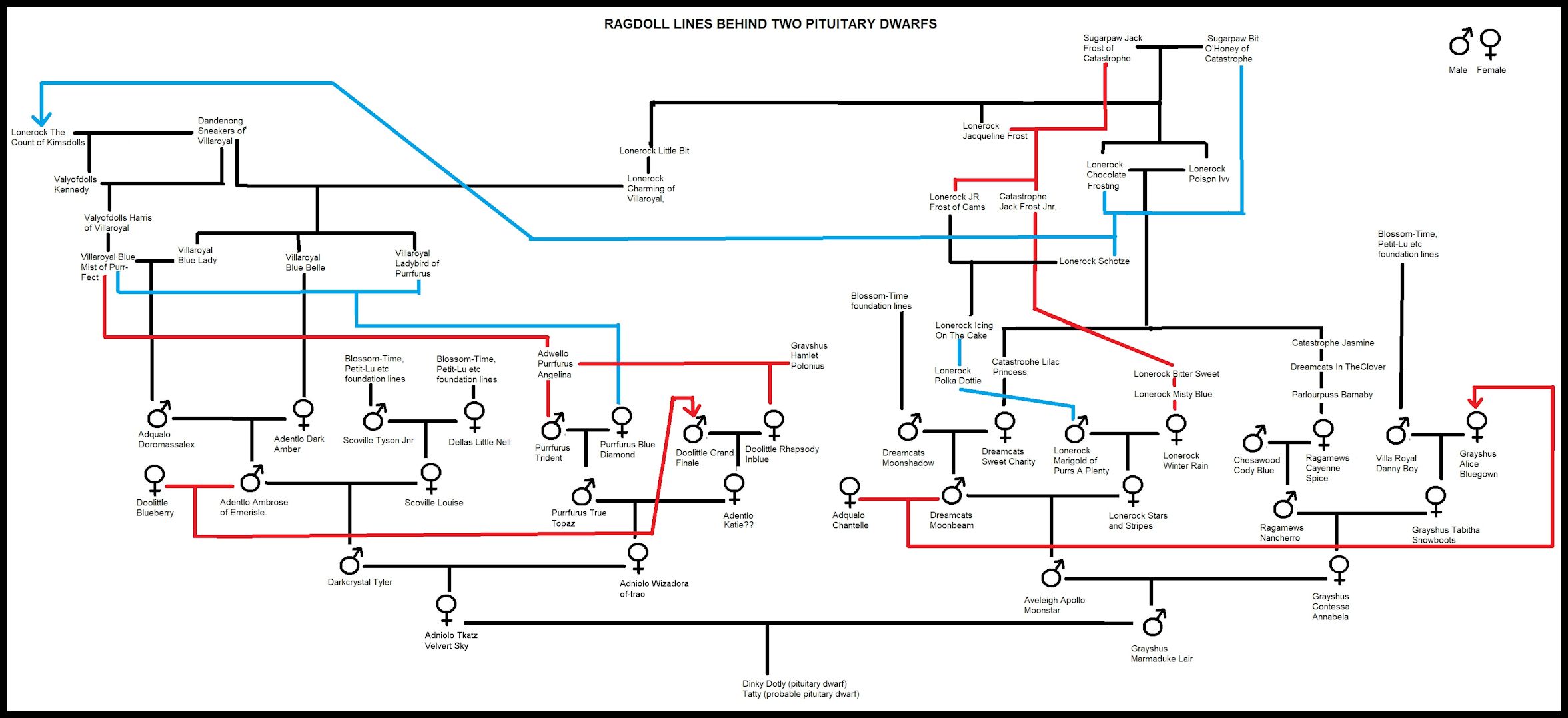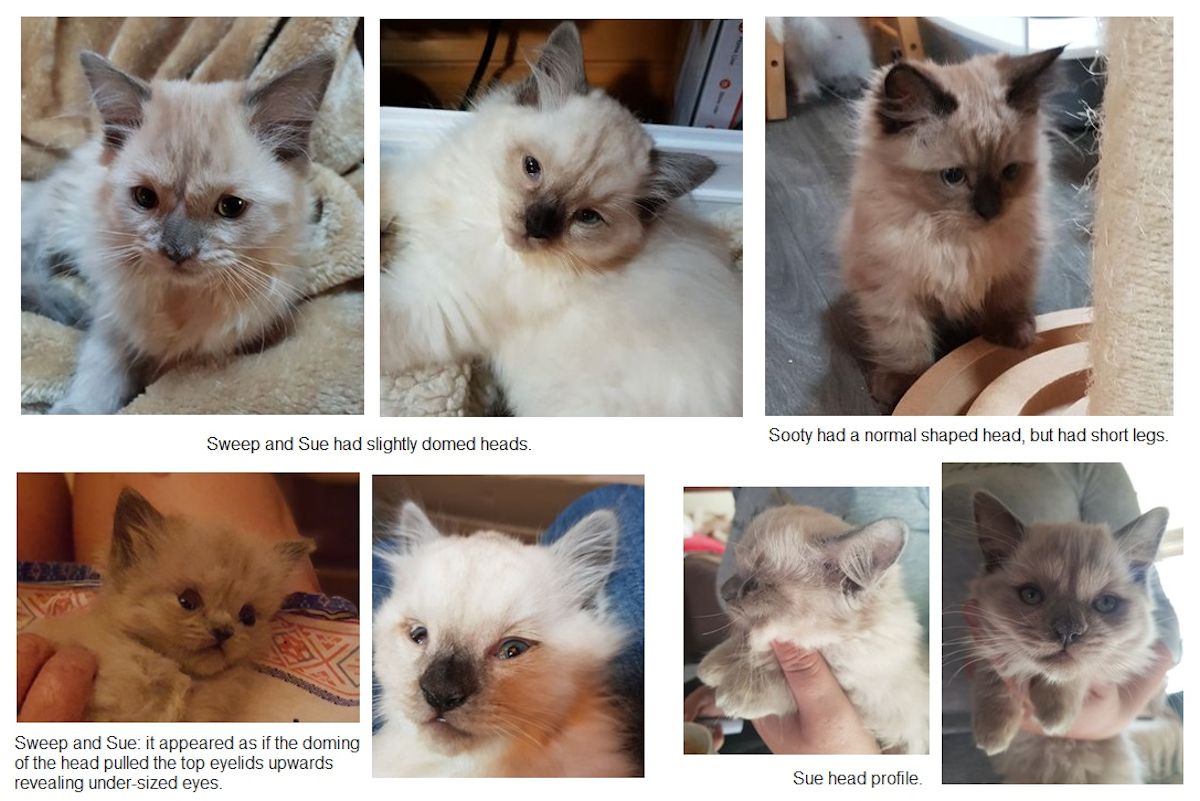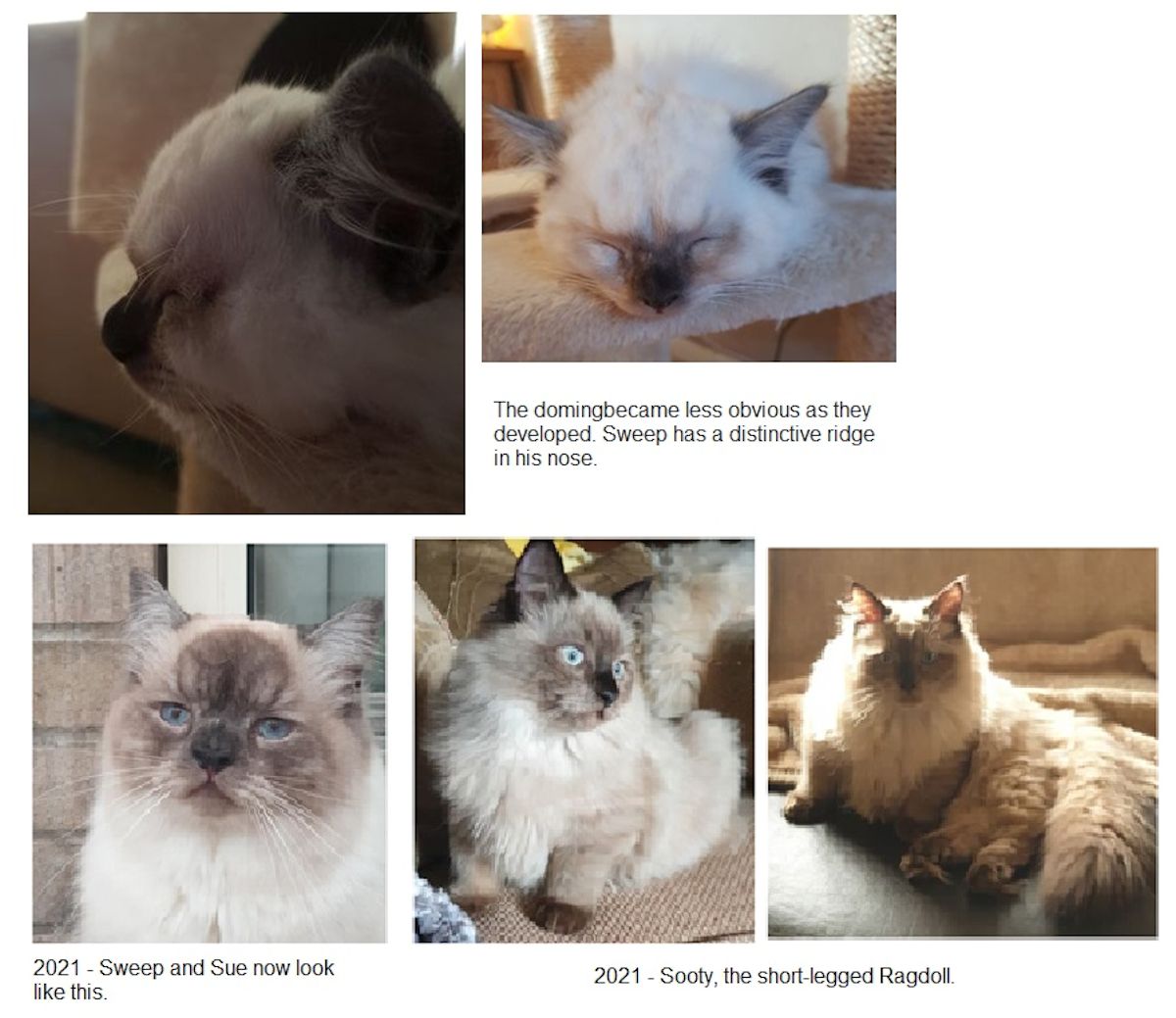
THE DWARF RAGDOLLS ENIGMA
These notes are based on breeders' observations of different types of dwarfism that have occurred in Ragdolls. They are reproduced here for the benefit of other breeders who may have encountered similar issues. It is a sensitive topic for many breeders, but there is a need to collect and exchange information, even if breeders prefer to remain anonymous. Some of the information has previously been published by The British Ragdoll Cat Club. Many of the cats' are also on publicly accessible pedigree databases and their names are in the public domain.
2011 – SOME PITUITARY DWARFS APPEAR
In 2011, breeder Helen Fitton had a pituitary dwarf ragdoll Tiny 'Genie' who thrived. Tiny's parents were Snugglepuss Flashoflight x Snugglepuss Poppie. Tiny's story was published in the 2012 or 2013 annual of The British Ragdoll Cat Club.
Pituitary dwarf Ragdoll "Tiny" was born on the 22nd March 2011; he is very healthy apart from has problems with nasal secretions. Tiny was born small out and stayed small and was a lethargic kitten. He collapsed at 11 weeks old because of constipation, followed by diarrhoea , and remained prostrated for some time, but pulled through. There were no signs of infection. Tiny was small from day one and his teeth did not come through until he was 18 weeks old. He tested positive for pituitary dwarfism.

Another Ragdoll breeder in Hampshire had a female pituitary dwarf Ragdoll born in 2012 and shared the same common ancestors with Tiny. This kitten presented just like Tiny and collapsed in exactly the same way, but did not pull through.
Tiny and the Hampshire kitten shared a common ancestor in Adentlo Ambrose of Emerisle. Emerisle produced many cats for breeding, meaning that Emerisle cats are over-represented in pedigrees of British Ragdolls and have shrunk the gene pool. Adentlo Ambrose of Emerisle traces back to Jack Frost and Bit O'Honey which are close to foundation level here, so if there is a recessive gene in the gene pool it could have been there from the beginnings of the breed.
In September 2013, three more pituitary dwarfs were born. One (a female called "Didge") was born in March and had the same sire as Tiny. Didge was perfectly formed and has her teeth, but at 4/5 weeks of age, her growth rate had slowed down in comparison to her littermates. She also had very sparse hair and almost translucent skin. In appearance, though not in growth pattern, Didge resembled Tiny. Her full coat came in around 15/16 weeks and she looked like a miniature Ragdoll. In August 2013 (age 23 weeks), she weighed in at 1.7kg while her normal-sized sisters weighed 2.4kg and 2.7kg. Didge died suddenly at one year old. Didge's parents were Flashoflight x Snugglepuss Kiska Sventlana.
The other two dwarf kittens born in 2013 were full-siblings to Tiny (Snugglepuss Flashoflight x Snugglepuss Poppie). They were part of a litter of five, and the remaining three grew at the normal rate. The dwarfed kittens are a male and a female and share the looks and growth pattern of Didge. By week 8/9, the kittens were lean and slender with large ears. At 14/15 weeks, their full coats developed.
Tiny's mum and Adecilo Opulence Sapphire (used twice) produced one dwarf kitten in each litter; one survived 21 days, the other survived 25 days. Both were small from birth, indicating pituitary dwarfism. Adentlo Ambrose of Emerisle is the parents' closest common ancestor.
For pituitary dwarfism, common ancestors are Lovebud Mr Cadbury and Adwello Leonardo (both link back to Pandapaws Coco Mero) and Donjelami Posie. We are close to foundation level here, so if there is a recessive gene in the gene pool it has been there almost from the start!
Another breeder lost a kitten in 2013, Dinky Dotly born to mother Sky, died when several weeks old and was the size of a 2 week old kitten. The sire traced back to Adentlo Ambrose of Emerisle (32 offspring registered on PawPeds). She also had another in 2014 called Tatty, he was put to sleep as he wasn't growing well; the vet suspected liver shunt, but the breeder now suspects Tatty was also a pituitary dwarf.
Family tree of the two pituitary dwarfs Dinky Dotly and Tatty. One born 2012, one 2014. It shows Adentlo Ambrose of Emerisle, the common ancestor, and the inbreeding at foundation level.

UNDETERMINED TYPES OF DWARFISM IN RAGDOLLS
A further dwarf Ragdoll was born in New Zealand and named Tinkie (possibly Turner Syndrome). The breeder is a biologist and thought that if dwarfism were a recessive gene from the foundation era breeders would have seen more of it in later generations.
Another UK breeder working with US Ragdoll lines had a dwarf kitten named Bo and had had two other dwarf kittens in 30 years of breeding.
2014 – A DIFFERENT KIND OF DWARFISM APPEARED – ACHONDROPASIA
In 2014 Helen also had dwarf Ragdoll "Flick" who had a different form of dwarfism, dyschondroplasia, and lived for only 16 weeks. Flick showed very bowed legs at 6 weeks old. Flick was the only one affected in a litter of 5 born 27/08/14. Flick's parents (Adecilo Opulence Sapphire x R*******ea Lunablu) were mated twice, their first litter only produced Flick, the second produced three normal kittens. [The owner of the prefix wanted it obscured, I have complied, but it can be found on publicly viewable pedigree databases, studbooks etc.]
Lunablu was an import from the U.S. and had Persian in her background. When she produced Flick, Helen did a repeat mating to Adecilo Opulence Sapphire. Lunablu was mated twice to Tiny's sire (FlashofLight) and twice to an unrelated home-bred stud, Yogie Bear. Flick and a later litter of three were the only affected offspring she produced from all of her matings.
Lunablu's daughter (from the second mating to Adecilo Opulence Sapphire) was mated to Snugglepuss Flashoflight, resulting in five completely normal kittens.

In 2018, Lunablu x Yogie Bear produced three kittens affected by achondroplasia. There were five in the litter, three of whom survived. Two appeared to have large domed heads by 3 weeks of age, the other appeared normal. The kittens with domed heads – Sweep and Sue - had small eyes, but this corrected itself by ten weeks. The kitten that appeared more normal at 11 weeks old, Sooty, developed short stumpy thick legs and the front legs had some deformity on the joint. These three all eat, play and act normally. Sooty runs and plays like any normal cat and has a hilarious personality. He just looked like a Munchkin. Sue died suddenly in July 2022 following a seizure although she had no history of seizures.

Initial thoughts were that Lunablu had an autosomal dominant from the mother; either a gene with variable expression or a germ-line mutation (a mutation in the ovarian tissue only). At the time there was a study into a lethal form of dwarfism in Swedish Ragdolls related to a cat called Patriarca Gucci ("PG"), but Helen's Ragdolls did not qualify for the study. The Scandinavian study was not funded for any research on cats not descended from Patriarca Gucci. I asked if any cats were submitted for that study had other types of dwarfism; the answer was yes, but the breeder did not wish to disclose details.
2016 –LETHAL DWARFISM IN SCANDINAVIAN RAGDOLLS
In Spring 2016, a different form of dwarfism, a deferred lethal mutation, in Ragdolls was being investigated by the Scandinavian Ragdoll Club. All affected kittens shared a particular ancestor on both the maternal and paternal side of their pedigree which indicated a recessive gene "doubling up." However there was not excessive inbreeding and the common ancestor may be 8-9 generations back in their pedigrees and is found in many of the popular and common breeding lines which means the gene may be widespread. The common ancestor was ES*Patriarca Gucci (female born in 2001, PG for short). Patrycja Mleczek has studied the Patriarca Gucci case over the years, and which lines produced dwarfs. She suspects that Gucci and her ancestors were not solely responsible. There was inbreeding in the ancestry of her mate, Showdolls Simon of Patriarca, and it is only in those lines (Simon Showdolls x Patriarca Gucci) where problems appeared. Patrycja believes the problems originate with the Persian cats that were introduced there. Not all of Gucci's offspring were carriers which is why a genetic test is important. Despite the wide gene pool, some carriers of the gene have been bred together. By April 2017, there were about 40 dwarf kittens born in Sweden and other countries. The study found that Hvenhildas Rufus, Hvenhildas Rakel and Hvenhildas Ulrik, offspring of Seierø's Prima Donna (Patriarca Gucci's daughter) had not produced dwarf offspring when mated to identified carriers; they were considered low-risk. There was no data about risks from Prima Donna's other offspring. On average, a recessive gene is transmitted to 50% of the offspring so breeders were advised to avoid breeding Patriarca Gucci's descendants to each other to avoid possible doubling up.
Note: Givhatol Neptun’s parentage is incorrectly recorded in some databases (PawPeds & Polish FPL FiFe) as Lonerock Peppermint Fatty x Juno of Givhatol. The correct parentage is Apollo of Givhatol x Juno of Givhatol.
The "PG" dwarf Ragdolls seen since 2016 had short legs, a short broad body, very short tail, small forward tilted ears, a broad head (almost cartoonishly oval) with a short nose and very dark blue eyes. Many had very small paws and underdeveloped hind legs. They were slow-moving and had a distinctive gait. At birth they were a normal weight, but by 2 weeks old they were obviously slower growing and less energetic than unaffected littermates. After 4-5 weeks old, the differences became gradually more pronounced. Affected kittens also suffered from constipation and did not live longer than 12-16 weeks old. Some kittens were more severely affected than others; the severely affected kittens lived for weeks while the mildly affected ones lived for months. Several were treated with the Levaxin (a drug used to treat congenital Hypothyroidism) and showed increased growth and activity, but died before 6 months old despite treatment. The prognosis is so poor that euthanasia is indicated once a kitten shows signs of this form of dwarfism.
The following forms of dwarfism were ruled out: Mucopolysaccharidosis I, Mucopolysaccharidosis VI, Mucopolysaccharidosis VII, Mucopolysaccharidosis VII (2), Mucopolysaccharidosis VII (3) and Hypothyroidism (1 variant). There were no available DNA tests for other forms of Mucopolysaccharidosis, other Lysosomal Storage Diseases or Hypothyroidism in cats. This means the dwarf kittens can be wrongly diagnosed as healthy despite their distinctive appearance and the known incidence of early mortality. In summer of 2016, Project Dwarfism was set up with the Swedish University of Agricultural Sciences (SLU) with the goal of developing a DNA test to detect the mutation so that confirmed carriers can be removed from breeding programmes.
LINECHASING
Lunablu, Flashoflight, Opulence Sapphire and Patriarca Gucci are distantly related (between 5 and 8 gens back) via a female called Lonerock Poison Ivy; Poison Ivy was sired by Sugarpaw Jack Frost of Catastrophe(who had 51 actively breeding offspring) and her dam was Sugarpaw Bit O'Honey of Catastrophe. Tiny's mother, Snugglepuss Poppie, also traces to Lonerock Poison Ivy at the 8th gen, but Tiny (100% traceable to Ragdoll foundation cats) had pituitary dwarfism while Sooty looked like a case of dyschondroplasia, affecting the limb length.
A family tree showed the common ancestors of Patriarca Gucci and one of Helen's sires. It also shows links back to foundation cats. (Click for larger images)
All lines, including Patriarca Gucci, trace back to Catastrophe and Lonerock cats (these belonged to a single breeder). Is it possible that the foundation cats had a recessive dwarfism gene that further mutated into the lethal PG form of dwarfism? Some early cats had names that possibly allude to smaller size e.g. Thumbelina, Little Boy.
SOME THOUGHTS FROM A BREEDER
I had a note from a RagaMuffin breeder who suspects a gene inherited from foundation cats. Here are excerpts: "If we haven't seen it in RagaMuffins yet but Ragdolls are seeing the number they have, regardless of whether it's in our pool or not, whatever we have done or are doing appears to be working so far.. . . . This must be some form of recessive dwarfism, separate from the known autosomal dominant gene that's used in Munchkins. . . . if it were dominant it wouldn't hide for this many generations and be as difficult to track. So assuming it's recessive in some way, I'd caution against discounting it going back to foundation. Foundation cats were gathered from many sources so essentially, F1 kittens had nearly a zero COI and heterozygosity % should still have been high. So little duplication of alleles in the kittens' genomes. As the ‘breeds' were developed, COI would've increased and heterozygosity would've decreased in progressive generations as type was getting set. If there were an unknown single carrier of this gene originally brought in at foundation, it would take several generations of interbreeding the chosen cats before duplication of the recessive gene would appear to ‘suddenly' pop up. Several generations if someone were intentionally trying to do it; several generations and more to see it pop up if it's wasn't known and wasn't intentionally selected for in pairings. . . . Simple Mendelian genetics says the earliest we could see it would be F2 if at the beginning littermates were bred together and both happened to carry it. There really was no need at F2 to breed this closely because of the number of cats [Ann Baker] was using. And it would require intentional selection for that or sheer bad luck to appear at F3. By F3 and on, the number of cats now being used for breeding would be significantly increased and not all kittens that carried the gene would remain in the genetic pool for breeding, effectively hiding the recessive gene even deeper. . . . Perhaps the one-off oddly affected kitten was born here and there and [Ann Baker] chalked it up to random deformity and just ‘eliminated' the kittens. There are many versions of how it could realistically have been brought in with foundation cats but not show up until many generations later. [Don't] discount that possibility yet just because the buck seems to stop at Ambrose. With the length of time we're looking at, I don't know that we will ever know for sure in regards to going back to foundation or not. The cats are no longer around and her record keeping wasn't immaculate or necessarily reliable in accuracy. Also if recessive and not a spontaneous mutation at the origin cat, the same cat would throw kittens that carry and those that don't carry . . . For RagaMuffins, I think it's likely sheer dumb luck that the ancestors are the offspring that didn't carry copies from either foundation cats or the origin cat of this condition . . . The answer to present to TICA or clubs ‘we can link several cats via a recent ancestor . . . but we cannot link Lunablu except at Catastrophe cats level. We don't know what, if any relationship there is to the dwarfism seen in Patriarca Gucci. We know it is not Munchkin-dwarfism because it is recessive.' "
With Sweep and Sue's development, it appeared almost as though the doming of the head pulled the top eyelids upwards revealing under-developed eyes. The doming became less obvious as they developed. Sweep had a distinctive ridge in his nose. Hydrocephalus was ruled out and the kittens had no problems with balance or co-ordination; apart from the head shape they were completely normal kittens. Sooty's cranial development appeared normal. All three had normal size feet, Sue and Sweep both had long legs, whereas Sooty had a broad chest and chunky thick short legs.